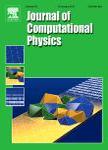版权所有:内蒙古大学图书馆 技术提供:维普资讯• 智图
内蒙古自治区呼和浩特市赛罕区大学西街235号 邮编: 010021

作者机构:Tech Univ Darmstadt Dept Mech Engn Chair Fluid Dynam D-64287 Darmstadt Germany Tech Univ Darmstadt Ctr Smart Interfaces D-64287 Darmstadt Germany Tech Univ Darmstadt Grad Sch Computat Engn D-64293 Darmstadt Germany
出 版 物:《JOURNAL OF COMPUTATIONAL PHYSICS》 (J. Comput. Phys.)
年 卷 期:2013年第237卷
页 面:235-250页
核心收录:
学科分类:07[理学] 0812[工学-计算机科学与技术(可授工学、理学学位)] 0702[理学-物理学]
基 金:Center of Smart Interfaces through a seed fund project German Science Foundation (DFG) through Research Grant [OB 96/31-1] German Science Foundation (DFG) through the research collaboration center SFB568 Graduate School Computational Engineering at the Technische Universitat Darmstadt
主 题:Finite element methods Discontinuous Galerkin methods Navier-Stokes equations Incompressible flows Segregated solution algorithms SIMPLE algorithm
摘 要:In this paper we present how the well-known SIMPLE algorithm can be extended to solve the steady incompressible Navier-Stokes equations discretized by the discontinuous Galerkin method. The convective part is discretized by the local Lax-Friedrichs fluxes and the viscous part by the symmetric interior penalty method. Within the SIMPLE algorithm, the equations are solved in an iterative process. The discretized equations are linearized and an equation for the pressure is derived on the discrete level. The equations obtained for each velocity component and the pressure are decoupled and therefore can be solved sequentially, leading to an efficient solution procedure. The extension of the proposed scheme to the unsteady case is straightforward, where fully implicit time schemes can be used. Various test cases are carried out: the Poiseuille flow, the channel flow with constant transpiration, the Kovasznay flow, the flow into a corner and the backward-facing step flow. Using a mixed-order formulation, i.e. order k for the velocity and order k - 1 for the pressure, the scheme is numerically stable for all test cases. Convergence rates of k + 1 and k in the L-2-norm are observed for velocity and pressure, respectively. A study of the convergence behavior of the SIMPLE algorithm shows that no under-relaxation for the pressure is needed, which is in strong contrast to the application of the SIMPLE algorithm in the context of the finite volume method or the continuous finite element method. We conclude that the proposed scheme is efficient to solve the steady incompressible Navier-Stokes equations in the context of the discontinuous Galerkin method comprising hp-accuracy. (c) 2012 Elsevier Inc. All rights reserved.